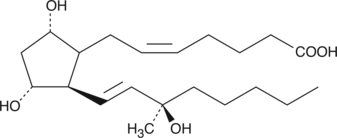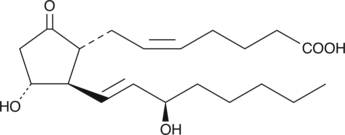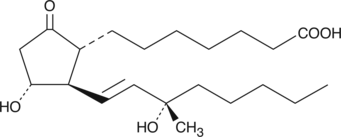Chemicals
Showing 3601–3750 of 41137 results
-
15-methyl Palmitic acid methyl ester is a methylated fatty acid methyl ester that has been found in S. zeai sea sponges as the fatty acyl component of zeamide, oolong tea (C. sinensis), and P. sulcate extract.{40927,36634,36635} It has been used as a standard for the quantification of 15-methyl palmitic acid (Item No. 24814) in various foods.{40918} [Matreya, LLC. Catalog No. 1602]
Brand:CaymanSKU:24815 - 10 mgAvailable on backorder
15-methyl Palmitic acid methyl ester is a methylated fatty acid methyl ester that has been found in S. zeai sea sponges as the fatty acyl component of zeamide, oolong tea (C. sinensis), and P. sulcate extract.{40927,36634,36635} It has been used as a standard for the quantification of 15-methyl palmitic acid (Item No. 24814) in various foods.{40918} [Matreya, LLC. Catalog No. 1602]
Brand:CaymanSKU:24815 - 25 mgAvailable on backorder
15-methyl Palmitic acid methyl ester is a methylated fatty acid methyl ester that has been found in S. zeai sea sponges as the fatty acyl component of zeamide, oolong tea (C. sinensis), and P. sulcate extract.{40927,36634,36635} It has been used as a standard for the quantification of 15-methyl palmitic acid (Item No. 24814) in various foods.{40918} [Matreya, LLC. Catalog No. 1602]
Brand:CaymanSKU:24815 - 5 mgAvailable on backorder
15-methyl Palmitic acid methyl ester is a methylated fatty acid methyl ester that has been found in S. zeai sea sponges as the fatty acyl component of zeamide, oolong tea (C. sinensis), and P. sulcate extract.{40927,36634,36635} It has been used as a standard for the quantification of 15-methyl palmitic acid (Item No. 24814) in various foods.{40918} [Matreya, LLC. Catalog No. 1602]
Brand:CaymanSKU:24815 - 50 mgAvailable on backorder
15-OxoEDE is produced by the oxidation of 15-HEDE. 15-OxoEDE inhibits 5-LO from RBL-1 cells with an IC50 of 55 µM, which is about 2-fold lower than 15(S)-HEDE.{951} A related oxo-eicosanoid, 5-oxoETE, is biosynthesized from 5(S)-HETE by a specific dehydrogenase and has potent inflammatory activity.{2090}
Brand:CaymanSKU:37730 - 100 µgAvailable on backorder
15-OxoEDE is produced by the oxidation of 15-HEDE. 15-OxoEDE inhibits 5-LO from RBL-1 cells with an IC50 of 55 µM, which is about 2-fold lower than 15(S)-HEDE.{951} A related oxo-eicosanoid, 5-oxoETE, is biosynthesized from 5(S)-HETE by a specific dehydrogenase and has potent inflammatory activity.{2090}
Brand:CaymanSKU:37730 - 25 µgAvailable on backorder
15-OxoEDE is produced by the oxidation of 15-HEDE. 15-OxoEDE inhibits 5-LO from RBL-1 cells with an IC50 of 55 µM, which is about 2-fold lower than 15(S)-HEDE.{951} A related oxo-eicosanoid, 5-oxoETE, is biosynthesized from 5(S)-HETE by a specific dehydrogenase and has potent inflammatory activity.{2090}
Brand:CaymanSKU:37730 - 250 µgAvailable on backorder
15-OxoEDE is produced by the oxidation of 15-HEDE. 15-OxoEDE inhibits 5-LO from RBL-1 cells with an IC50 of 55 µM, which is about 2-fold lower than 15(S)-HEDE.{951} A related oxo-eicosanoid, 5-oxoETE, is biosynthesized from 5(S)-HETE by a specific dehydrogenase and has potent inflammatory activity.{2090}
Brand:CaymanSKU:37730 - 50 µgAvailable on backorder
15-OxoETE is produced by oxidation of the 15-hydroxyl of 15-HETE.{2793} Whether this is a major pathway of 15-HETE metabolism is yet to be clearly established.
Brand:CaymanSKU:34730 - 100 µgAvailable on backorder
15-OxoETE is produced by oxidation of the 15-hydroxyl of 15-HETE.{2793} Whether this is a major pathway of 15-HETE metabolism is yet to be clearly established.
Brand:CaymanSKU:34730 - 25 µgAvailable on backorder
15-OxoETE is produced by oxidation of the 15-hydroxyl of 15-HETE.{2793} Whether this is a major pathway of 15-HETE metabolism is yet to be clearly established.
Brand:CaymanSKU:34730 - 250 µgAvailable on backorder
15-OxoETE is produced by oxidation of the 15-hydroxyl of 15-HETE.{2793} Whether this is a major pathway of 15-HETE metabolism is yet to be clearly established.
Brand:CaymanSKU:34730 - 50 µgAvailable on backorder
15,16-Dihydrotanshinone I (DHTS) is a diterpene tanshinone that has been found in the roots of S. miltiorrhiza with diverse biological activities.{39842} DHTS inhibits RHL-2H3 mast cell degranulation with an IC50 value of 14.3 μM and reduces the tyrosine phosphorylation of phospholipase Cγ2 (PLCγ2) and ERK.{39843} It prevents HuR binding to RNA in a cell-free assay (Ki = 3.74 nM) and inhibits the production of TNF mRNA and protein in MCF-7 cells.{39842} DHTS reduces the viability of MCF-7, MDA-MB-231, and SK-BR-3 breast cancer cells with IC50 values of 0.84, 0.92, and 1.2 μM, respectively. It also reduces collagen-induced aggregation of washed rabbit platelets (IC50 = 8.7 μM).{39844} In vivo, DHTS (25 mg/kg per day) reduces tumor growth in an HL-60 leukemia mouse xenograft model by 68% relative to control without decreasing body weight.{39845} In mice with scopolamine-induced learning and memory impairment, DHTS (2-4 mg/kg, p.o.) increases latency to step-through in a passive avoidance test by approximately 3- to 4-fold, and it inhibits acetylcholinesterase in brain homogenate (IC50 = 25 μM).{39846}
Brand:CaymanSKU:25051 - 10 mgAvailable on backorder
15,16-Dihydrotanshinone I (DHTS) is a diterpene tanshinone that has been found in the roots of S. miltiorrhiza with diverse biological activities.{39842} DHTS inhibits RHL-2H3 mast cell degranulation with an IC50 value of 14.3 μM and reduces the tyrosine phosphorylation of phospholipase Cγ2 (PLCγ2) and ERK.{39843} It prevents HuR binding to RNA in a cell-free assay (Ki = 3.74 nM) and inhibits the production of TNF mRNA and protein in MCF-7 cells.{39842} DHTS reduces the viability of MCF-7, MDA-MB-231, and SK-BR-3 breast cancer cells with IC50 values of 0.84, 0.92, and 1.2 μM, respectively. It also reduces collagen-induced aggregation of washed rabbit platelets (IC50 = 8.7 μM).{39844} In vivo, DHTS (25 mg/kg per day) reduces tumor growth in an HL-60 leukemia mouse xenograft model by 68% relative to control without decreasing body weight.{39845} In mice with scopolamine-induced learning and memory impairment, DHTS (2-4 mg/kg, p.o.) increases latency to step-through in a passive avoidance test by approximately 3- to 4-fold, and it inhibits acetylcholinesterase in brain homogenate (IC50 = 25 μM).{39846}
Brand:CaymanSKU:25051 - 25 mgAvailable on backorder
15,16-Dihydrotanshinone I (DHTS) is a diterpene tanshinone that has been found in the roots of S. miltiorrhiza with diverse biological activities.{39842} DHTS inhibits RHL-2H3 mast cell degranulation with an IC50 value of 14.3 μM and reduces the tyrosine phosphorylation of phospholipase Cγ2 (PLCγ2) and ERK.{39843} It prevents HuR binding to RNA in a cell-free assay (Ki = 3.74 nM) and inhibits the production of TNF mRNA and protein in MCF-7 cells.{39842} DHTS reduces the viability of MCF-7, MDA-MB-231, and SK-BR-3 breast cancer cells with IC50 values of 0.84, 0.92, and 1.2 μM, respectively. It also reduces collagen-induced aggregation of washed rabbit platelets (IC50 = 8.7 μM).{39844} In vivo, DHTS (25 mg/kg per day) reduces tumor growth in an HL-60 leukemia mouse xenograft model by 68% relative to control without decreasing body weight.{39845} In mice with scopolamine-induced learning and memory impairment, DHTS (2-4 mg/kg, p.o.) increases latency to step-through in a passive avoidance test by approximately 3- to 4-fold, and it inhibits acetylcholinesterase in brain homogenate (IC50 = 25 μM).{39846}
Brand:CaymanSKU:25051 - 5 mgAvailable on backorder
15,16-Dihydrotanshinone I (DHTS) is a diterpene tanshinone that has been found in the roots of S. miltiorrhiza with diverse biological activities.{39842} DHTS inhibits RHL-2H3 mast cell degranulation with an IC50 value of 14.3 μM and reduces the tyrosine phosphorylation of phospholipase Cγ2 (PLCγ2) and ERK.{39843} It prevents HuR binding to RNA in a cell-free assay (Ki = 3.74 nM) and inhibits the production of TNF mRNA and protein in MCF-7 cells.{39842} DHTS reduces the viability of MCF-7, MDA-MB-231, and SK-BR-3 breast cancer cells with IC50 values of 0.84, 0.92, and 1.2 μM, respectively. It also reduces collagen-induced aggregation of washed rabbit platelets (IC50 = 8.7 μM).{39844} In vivo, DHTS (25 mg/kg per day) reduces tumor growth in an HL-60 leukemia mouse xenograft model by 68% relative to control without decreasing body weight.{39845} In mice with scopolamine-induced learning and memory impairment, DHTS (2-4 mg/kg, p.o.) increases latency to step-through in a passive avoidance test by approximately 3- to 4-fold, and it inhibits acetylcholinesterase in brain homogenate (IC50 = 25 μM).{39846}
Brand:CaymanSKU:25051 - 50 mgAvailable on backorder
Arbaprostil (15(R)-15-methyl prostaglandin E2) is a synthetic prostaglandin E2 (PGE2) analog developed for its cytoprotective activity.{2958} 15(R)-15-methyl Prostaglandin A2 (15(R)-15-methyl PGA2) is one of several impurities which are possible in the production of commercial lots of bulk arbaprostil.{2016} The pharmacology and EP receptor binding affinity for 15(R)-15-methyl PGA2 has not been published.
Brand:CaymanSKU:10270 - 1 mgAvailable on backorder
Arbaprostil (15(R)-15-methyl prostaglandin E2) is a synthetic prostaglandin E2 (PGE2) analog developed for its cytoprotective activity.{2958} 15(R)-15-methyl Prostaglandin A2 (15(R)-15-methyl PGA2) is one of several impurities which are possible in the production of commercial lots of bulk arbaprostil.{2016} The pharmacology and EP receptor binding affinity for 15(R)-15-methyl PGA2 has not been published.
Brand:CaymanSKU:10270 - 10 mgAvailable on backorder
Arbaprostil (15(R)-15-methyl prostaglandin E2) is a synthetic prostaglandin E2 (PGE2) analog developed for its cytoprotective activity.{2958} 15(R)-15-methyl Prostaglandin A2 (15(R)-15-methyl PGA2) is one of several impurities which are possible in the production of commercial lots of bulk arbaprostil.{2016} The pharmacology and EP receptor binding affinity for 15(R)-15-methyl PGA2 has not been published.
Brand:CaymanSKU:10270 - 5 mgAvailable on backorder
15(R)-15-methyl Prostaglandin D2 (15(R)-15-methyl PGD2) is a metabolically stable synthetic analog of PGD2 (Item No. 12010). The physiological actions of PGD2 include regulation of sleep, lowering of body temperature, inhibition of platelet aggregation and relaxation of vascular smooth muscle.{328,1185,580} PGD2 mediates its effects by 2 distinct G-protein-coupled receptors, DP1{3128} and CRTH2/DP2.{10722,9769} 15(R)-15-methyl PGD2 is a potent, selective agonist for the CRTH2/DP2 receptor.{10723} The EC50 values for eosinophil CD11b expression, actin polymerization, and chemotaxis are 1.4, 3.8, and 1.7 nM, respectively, each of which is approximately 3-5 fold lower than those for PGD2. In contrast the EC50 for the DP1-mediated increase in platelet cAMP by 15(R)-15-methyl PGD2 is >10 µM.{10723}
Brand:CaymanSKU:12720 - 1 mgAvailable on backorder
15(R)-15-methyl Prostaglandin D2 (15(R)-15-methyl PGD2) is a metabolically stable synthetic analog of PGD2 (Item No. 12010). The physiological actions of PGD2 include regulation of sleep, lowering of body temperature, inhibition of platelet aggregation and relaxation of vascular smooth muscle.{328,1185,580} PGD2 mediates its effects by 2 distinct G-protein-coupled receptors, DP1{3128} and CRTH2/DP2.{10722,9769} 15(R)-15-methyl PGD2 is a potent, selective agonist for the CRTH2/DP2 receptor.{10723} The EC50 values for eosinophil CD11b expression, actin polymerization, and chemotaxis are 1.4, 3.8, and 1.7 nM, respectively, each of which is approximately 3-5 fold lower than those for PGD2. In contrast the EC50 for the DP1-mediated increase in platelet cAMP by 15(R)-15-methyl PGD2 is >10 µM.{10723}
Brand:CaymanSKU:12720 - 5 mgAvailable on backorder
15(R)-15-methyl Prostaglandin D2 (15(R)-15-methyl PGD2) is a metabolically stable synthetic analog of PGD2 (Item No. 12010). The physiological actions of PGD2 include regulation of sleep, lowering of body temperature, inhibition of platelet aggregation and relaxation of vascular smooth muscle.{328,1185,580} PGD2 mediates its effects by 2 distinct G-protein-coupled receptors, DP1{3128} and CRTH2/DP2.{10722,9769} 15(R)-15-methyl PGD2 is a potent, selective agonist for the CRTH2/DP2 receptor.{10723} The EC50 values for eosinophil CD11b expression, actin polymerization, and chemotaxis are 1.4, 3.8, and 1.7 nM, respectively, each of which is approximately 3-5 fold lower than those for PGD2. In contrast the EC50 for the DP1-mediated increase in platelet cAMP by 15(R)-15-methyl PGD2 is >10 µM.{10723}
Brand:CaymanSKU:12720 - 500 µgAvailable on backorder
15(R)-15-methyl Prostaglandin E2 (15(R)-15-methyl PGE2) is a prodrug for the potent PGE2 (Item No. 14010) analog 15(S)-15-methyl PGE2 (Item No. 14730).{1994} Acid-catalyzed epimerization in the stomach produces the 15(S)-hydroxy compound which is biologically active.{1150} Oral administration of 15(R)-15-methyl PGE2 to dogs or rats at 10-300 µg/kg results in a dose-dependent inhibition of gastric acid secretion and an increase in the rate of duodenal bicarbonate secretion.{1151,1152}
Brand:CaymanSKU:-15(R)-15-methyl Prostaglandin E2 (15(R)-15-methyl PGE2) is a prodrug for the potent PGE2 (Item No. 14010) analog 15(S)-15-methyl PGE2 (Item No. 14730).{1994} Acid-catalyzed epimerization in the stomach produces the 15(S)-hydroxy compound which is biologically active.{1150} Oral administration of 15(R)-15-methyl PGE2 to dogs or rats at 10-300 µg/kg results in a dose-dependent inhibition of gastric acid secretion and an increase in the rate of duodenal bicarbonate secretion.{1151,1152}
Brand:CaymanSKU:-15(R)-15-methyl PGF2α is a metabolically stable analog of PGF2α. 15(R)-15-methyl PGF2α is an inactive, prodrug PGF agonist designed for activation by gastric acid after oral administration. Acid-catalyzed epimerization of 15(R)-15-methyl PGF2α converts it into the active 15(S)-isomer.{4631,1989} The 15(S)-isomer induces luteolysis when injected in rhesus monkeys at a dose of about 12 mg/animal, while the 15(R)-isomer does not.{4632}
Brand:CaymanSKU:-Out of stock
15(R)-15-methyl PGF2α is a metabolically stable analog of PGF2α. 15(R)-15-methyl PGF2α is an inactive, prodrug PGF agonist designed for activation by gastric acid after oral administration. Acid-catalyzed epimerization of 15(R)-15-methyl PGF2α converts it into the active 15(S)-isomer.{4631,1989} The 15(S)-isomer induces luteolysis when injected in rhesus monkeys at a dose of about 12 mg/animal, while the 15(R)-isomer does not.{4632}
Brand:CaymanSKU:-Out of stock
15(R)-15-methyl Prostaglandin F2α methyl ester (15(R)-15-methyl PGF2α methyl ester) is a lipid soluble prodrug form of 15(R)-15-methyl PGF2α (Item No. 16730) with increased membrane permeability. Acid-catalyzed epimerization of 15(R)-15-methyl PGF2α methyl ester and hydrolysis of the ester converts it into the active 15(S)-15-methyl PGF2α (Item No. 16743).{4631,1989}
Brand:CaymanSKU:-Out of stock
15(R)-15-methyl Prostaglandin F2α methyl ester (15(R)-15-methyl PGF2α methyl ester) is a lipid soluble prodrug form of 15(R)-15-methyl PGF2α (Item No. 16730) with increased membrane permeability. Acid-catalyzed epimerization of 15(R)-15-methyl PGF2α methyl ester and hydrolysis of the ester converts it into the active 15(S)-15-methyl PGF2α (Item No. 16743).{4631,1989}
Brand:CaymanSKU:-Out of stock
17-phenyl trinor Prostaglandin F2α N-ethyl amide (17-phenyl trinor PGF2α) is an F-series prostaglandin analog which has been approved for use as an ocular hypotensive drug, sold under the Allergan trade name 17-phenyl trinor PGF2α ethyl amide.{8941} Investigations in our lab have shown that 17-phenyl trinor PGF2α ethyl amide is converted by an amidase enzymatic activity in the human cornea to yield the corresponding free acid, with a conversion rate of about 25 µg/cornea/24 hours.{9311} The free acid, 17-phenyl trinor PGF2α, is a potent FP receptor agonist.{2058,1374} 15(R)-17-phenyl trinor PGF2α is the 15-epi, or “unnatural” isomer of this active free acid metabolite. It has much diminished FP receptor-mediated activity, which is generally 1.5 to 2 logs less than the 15(S)-isomer.{9736} In human and animal models of glaucoma, FP receptor agonist activity corresponds very closely with intraocular hypotensive activity.
Brand:CaymanSKU:-Out of stock
17-phenyl trinor Prostaglandin F2α N-ethyl amide (17-phenyl trinor PGF2α) is an F-series prostaglandin analog which has been approved for use as an ocular hypotensive drug, sold under the Allergan trade name 17-phenyl trinor PGF2α ethyl amide.{8941} Investigations in our lab have shown that 17-phenyl trinor PGF2α ethyl amide is converted by an amidase enzymatic activity in the human cornea to yield the corresponding free acid, with a conversion rate of about 25 µg/cornea/24 hours.{9311} The free acid, 17-phenyl trinor PGF2α, is a potent FP receptor agonist.{2058,1374} 15(R)-17-phenyl trinor PGF2α is the 15-epi, or “unnatural” isomer of this active free acid metabolite. It has much diminished FP receptor-mediated activity, which is generally 1.5 to 2 logs less than the 15(S)-isomer.{9736} In human and animal models of glaucoma, FP receptor agonist activity corresponds very closely with intraocular hypotensive activity.
Brand:CaymanSKU:-Out of stock
17-phenyl trinor Prostaglandin F2α N-ethyl amide (17-phenyl trinor PGF2α) is an F-series prostaglandin analog which has been approved for use as an ocular hypotensive drug, sold under the Allergan trade name 17-phenyl trinor PGF2α ethyl amide.{8941} Investigations in our lab have shown that 17-phenyl trinor PGF2α ethyl amide is converted by an amidase enzymatic activity in the human cornea to yield the corresponding free acid, with a conversion rate of about 25 µg/cornea/24 hours.{9311} The free acid, 17-phenyl trinor PGF2α, is a potent FP receptor agonist.{2058,1374} 15(R)-17-phenyl trinor PGF2α is the 15-epi, or “unnatural” isomer of this active free acid metabolite. It has much diminished FP receptor-mediated activity, which is generally 1.5 to 2 logs less than the 15(S)-isomer.{9736} In human and animal models of glaucoma, FP receptor agonist activity corresponds very closely with intraocular hypotensive activity.
Brand:CaymanSKU:-Out of stock
15(R)-17-phenyl trinor Prostaglandin F2α ethyl amide (15(R)-17-phenyl trinor PGF2α ethyl amide) is an isomer of bimatoprost, characterized by an inverted (β) hydroxyl group at C-15. While this isomer has not been characterized, the comparable inversion of 15-hydroxyl groups, from (S) to (R), on other PGF2α analogs typically decreases, but does not eliminate, activity.{9736}
Brand:CaymanSKU:10008127 - 1 mgAvailable on backorder
15(R)-17-phenyl trinor Prostaglandin F2α ethyl amide (15(R)-17-phenyl trinor PGF2α ethyl amide) is an isomer of bimatoprost, characterized by an inverted (β) hydroxyl group at C-15. While this isomer has not been characterized, the comparable inversion of 15-hydroxyl groups, from (S) to (R), on other PGF2α analogs typically decreases, but does not eliminate, activity.{9736}
Brand:CaymanSKU:10008127 - 10 mgAvailable on backorder
15(R)-17-phenyl trinor Prostaglandin F2α ethyl amide (15(R)-17-phenyl trinor PGF2α ethyl amide) is an isomer of bimatoprost, characterized by an inverted (β) hydroxyl group at C-15. While this isomer has not been characterized, the comparable inversion of 15-hydroxyl groups, from (S) to (R), on other PGF2α analogs typically decreases, but does not eliminate, activity.{9736}
Brand:CaymanSKU:10008127 - 5 mgAvailable on backorder
15(R)-17-phenyl trinor Prostaglandin F2α ethyl amide (15(R)-17-phenyl trinor PGF2α ethyl amide) is an isomer of bimatoprost, characterized by an inverted (β) hydroxyl group at C-15. While this isomer has not been characterized, the comparable inversion of 15-hydroxyl groups, from (S) to (R), on other PGF2α analogs typically decreases, but does not eliminate, activity.{9736}
Brand:CaymanSKU:10008127 - 500 µgAvailable on backorder
15(R)-17-phenyl trinor Prostaglandin F2α isopropyl ester (15(R)-17-phenyl trinor PGF2α isopropyl ester) is the latanoprost-related isomer containing both a double bond at 13,14 and an inverted (β) hydroxyl group at C-15. Similar to 15(S)-latanoprost, 15(R)-17-phenyl trinor PGF2α isopropyl ester is a potential impurity in most commercial preparations of the latanoprost bulk drug product. The IC50 values for the free acid forms of 15(S)-17-phenyl trinor PGF2α and 15(R)-17-phenyl trinor PGF2α were determined to be 0.71 nM and 30 nM, respectively, in a FP receptor binding assay using the cat iris sphincter muscle.{9736} A 3 µg dose of 15(R)-17-phenyl trinor PGF2α caused a 1.9 mmHg reduction of IOP in normotensive cynomolgus monkeys.{9736}
Brand:CaymanSKU:-Out of stock
15(R)-17-phenyl trinor Prostaglandin F2α isopropyl ester (15(R)-17-phenyl trinor PGF2α isopropyl ester) is the latanoprost-related isomer containing both a double bond at 13,14 and an inverted (β) hydroxyl group at C-15. Similar to 15(S)-latanoprost, 15(R)-17-phenyl trinor PGF2α isopropyl ester is a potential impurity in most commercial preparations of the latanoprost bulk drug product. The IC50 values for the free acid forms of 15(S)-17-phenyl trinor PGF2α and 15(R)-17-phenyl trinor PGF2α were determined to be 0.71 nM and 30 nM, respectively, in a FP receptor binding assay using the cat iris sphincter muscle.{9736} A 3 µg dose of 15(R)-17-phenyl trinor PGF2α caused a 1.9 mmHg reduction of IOP in normotensive cynomolgus monkeys.{9736}
Brand:CaymanSKU:-Out of stock
15(R)-17-phenyl trinor Prostaglandin F2α isopropyl ester (15(R)-17-phenyl trinor PGF2α isopropyl ester) is the latanoprost-related isomer containing both a double bond at 13,14 and an inverted (β) hydroxyl group at C-15. Similar to 15(S)-latanoprost, 15(R)-17-phenyl trinor PGF2α isopropyl ester is a potential impurity in most commercial preparations of the latanoprost bulk drug product. The IC50 values for the free acid forms of 15(S)-17-phenyl trinor PGF2α and 15(R)-17-phenyl trinor PGF2α were determined to be 0.71 nM and 30 nM, respectively, in a FP receptor binding assay using the cat iris sphincter muscle.{9736} A 3 µg dose of 15(R)-17-phenyl trinor PGF2α caused a 1.9 mmHg reduction of IOP in normotensive cynomolgus monkeys.{9736}
Brand:CaymanSKU:-Out of stock
15(R)-17-phenyl trinor Prostaglandin F2α isopropyl ester (15(R)-17-phenyl trinor PGF2α isopropyl ester) is the latanoprost-related isomer containing both a double bond at 13,14 and an inverted (β) hydroxyl group at C-15. Similar to 15(S)-latanoprost, 15(R)-17-phenyl trinor PGF2α isopropyl ester is a potential impurity in most commercial preparations of the latanoprost bulk drug product. The IC50 values for the free acid forms of 15(S)-17-phenyl trinor PGF2α and 15(R)-17-phenyl trinor PGF2α were determined to be 0.71 nM and 30 nM, respectively, in a FP receptor binding assay using the cat iris sphincter muscle.{9736} A 3 µg dose of 15(R)-17-phenyl trinor PGF2α caused a 1.9 mmHg reduction of IOP in normotensive cynomolgus monkeys.{9736}
Brand:CaymanSKU:-Out of stock
15(R)-HEDE is isolated by the chromatographic resolution of (±)15-HEDE. There are no reports of biological activity associated with 15(R)-HEDE in the literature.
Brand:CaymanSKU:37710 - 100 µgAvailable on backorder
15(R)-HEDE is isolated by the chromatographic resolution of (±)15-HEDE. There are no reports of biological activity associated with 15(R)-HEDE in the literature.
Brand:CaymanSKU:37710 - 25 µgAvailable on backorder
15(R)-HEDE is isolated by the chromatographic resolution of (±)15-HEDE. There are no reports of biological activity associated with 15(R)-HEDE in the literature.
Brand:CaymanSKU:37710 - 250 µgAvailable on backorder
15(R)-HEDE is isolated by the chromatographic resolution of (±)15-HEDE. There are no reports of biological activity associated with 15(R)-HEDE in the literature.
Brand:CaymanSKU:37710 - 50 µgAvailable on backorder
15(R)-HETE is produced when aspirin-inhibited COX-2 is incubated with arachidonic acid.{1504,1506} The clinical significance of 15(R)-HETE and its potential downstream metabolites is the subject of current investigations.{3520,10156}
Brand:CaymanSKU:34710 - 100 µgAvailable on backorder
15(R)-HETE is produced when aspirin-inhibited COX-2 is incubated with arachidonic acid.{1504,1506} The clinical significance of 15(R)-HETE and its potential downstream metabolites is the subject of current investigations.{3520,10156}
Brand:CaymanSKU:34710 - 25 µgAvailable on backorder
15(R)-HETE is produced when aspirin-inhibited COX-2 is incubated with arachidonic acid.{1504,1506} The clinical significance of 15(R)-HETE and its potential downstream metabolites is the subject of current investigations.{3520,10156}
Brand:CaymanSKU:34710 - 50 µgAvailable on backorder
Iloprost is a second generation structural analog of prostacyclin (PGI2) with about ten-fold greater potency than the first generation stable analogs, typified by carbaprostacyclin.{3347} Iloprost binds with equal affinity to the recombinant human IP and EP receptors with a Ki of 11 nM.{8322} 15(R)-Iloprost is the “unnatural” or inverted C-15 epimer of iloprost. This transformation frequently attenuates the biological agonist activity of prostaglandin analogs by several orders of magnitude. There are no literature reports of the biological activity of 15(R)-iloprost.
Brand:CaymanSKU:10043 - 1 mgAvailable on backorder
Iloprost is a second generation structural analog of prostacyclin (PGI2) with about ten-fold greater potency than the first generation stable analogs, typified by carbaprostacyclin.{3347} Iloprost binds with equal affinity to the recombinant human IP and EP receptors with a Ki of 11 nM.{8322} 15(R)-Iloprost is the “unnatural” or inverted C-15 epimer of iloprost. This transformation frequently attenuates the biological agonist activity of prostaglandin analogs by several orders of magnitude. There are no literature reports of the biological activity of 15(R)-iloprost.
Brand:CaymanSKU:10043 - 10 mgAvailable on backorder
Iloprost is a second generation structural analog of prostacyclin (PGI2) with about ten-fold greater potency than the first generation stable analogs, typified by carbaprostacyclin.{3347} Iloprost binds with equal affinity to the recombinant human IP and EP receptors with a Ki of 11 nM.{8322} 15(R)-Iloprost is the “unnatural” or inverted C-15 epimer of iloprost. This transformation frequently attenuates the biological agonist activity of prostaglandin analogs by several orders of magnitude. There are no literature reports of the biological activity of 15(R)-iloprost.
Brand:CaymanSKU:10043 - 5 mgAvailable on backorder
Iloprost is a second generation structural analog of prostacyclin (PGI2) with about ten-fold greater potency than the first generation stable analogs, typified by carbaprostacyclin.{3347} Iloprost binds with equal affinity to the recombinant human IP and EP receptors with a Ki of 11 nM.{8322} 15(R)-Iloprost is the “unnatural” or inverted C-15 epimer of iloprost. This transformation frequently attenuates the biological agonist activity of prostaglandin analogs by several orders of magnitude. There are no literature reports of the biological activity of 15(R)-iloprost.
Brand:CaymanSKU:10043 - 500 µgAvailable on backorder
Lipid-derived lipoxins are produced at the site of vascular and mucosal inflammation where they down-regulate polymorphonuclear leukocyte recruitment and function. 15(R)-Lipoxin A4 (15(R)-LXA4) is derived from the aspirin-triggered formation of 15(R)-HETE (Item No. 34710) from arachidonic acid (Item No. 90010).{3520,2629} 15(R)-LXA4 inhibits LTB4-induced chemotaxis, adherence, and transmigration of neutrophils with twice the potency of LXA4 (Item No. 90410) demonstrating activity in the nM range.{2629,11078} The anti-inflammatory effects of aspirin may be ascribed in part to the ability of 15(R)-LXA4 to regulate leukocyte function.{15182} 15(R)-LXA4 is reported to promote resolution of inflammation in LPS-treated stromal cells derived from intermediate-stage diseased supraspinatus tendons as evidenced by increased expression of the STAT-6 pathway target genes, ALOX15 and CD206.{29947}
Brand:CaymanSKU:90415 - 100 µgAvailable on backorder
Lipid-derived lipoxins are produced at the site of vascular and mucosal inflammation where they down-regulate polymorphonuclear leukocyte recruitment and function. 15(R)-Lipoxin A4 (15(R)-LXA4) is derived from the aspirin-triggered formation of 15(R)-HETE (Item No. 34710) from arachidonic acid (Item No. 90010).{3520,2629} 15(R)-LXA4 inhibits LTB4-induced chemotaxis, adherence, and transmigration of neutrophils with twice the potency of LXA4 (Item No. 90410) demonstrating activity in the nM range.{2629,11078} The anti-inflammatory effects of aspirin may be ascribed in part to the ability of 15(R)-LXA4 to regulate leukocyte function.{15182} 15(R)-LXA4 is reported to promote resolution of inflammation in LPS-treated stromal cells derived from intermediate-stage diseased supraspinatus tendons as evidenced by increased expression of the STAT-6 pathway target genes, ALOX15 and CD206.{29947}
Brand:CaymanSKU:90415 - 25 µgAvailable on backorder
Lipid-derived lipoxins are produced at the site of vascular and mucosal inflammation where they down-regulate polymorphonuclear leukocyte recruitment and function. 15(R)-Lipoxin A4 (15(R)-LXA4) is derived from the aspirin-triggered formation of 15(R)-HETE (Item No. 34710) from arachidonic acid (Item No. 90010).{3520,2629} 15(R)-LXA4 inhibits LTB4-induced chemotaxis, adherence, and transmigration of neutrophils with twice the potency of LXA4 (Item No. 90410) demonstrating activity in the nM range.{2629,11078} The anti-inflammatory effects of aspirin may be ascribed in part to the ability of 15(R)-LXA4 to regulate leukocyte function.{15182} 15(R)-LXA4 is reported to promote resolution of inflammation in LPS-treated stromal cells derived from intermediate-stage diseased supraspinatus tendons as evidenced by increased expression of the STAT-6 pathway target genes, ALOX15 and CD206.{29947}
Brand:CaymanSKU:90415 - 250 µgAvailable on backorder
Lipid-derived lipoxins are produced at the site of vascular and mucosal inflammation where they down-regulate polymorphonuclear leukocyte recruitment and function. 15(R)-Lipoxin A4 (15(R)-LXA4) is derived from the aspirin-triggered formation of 15(R)-HETE (Item No. 34710) from arachidonic acid (Item No. 90010).{3520,2629} 15(R)-LXA4 inhibits LTB4-induced chemotaxis, adherence, and transmigration of neutrophils with twice the potency of LXA4 (Item No. 90410) demonstrating activity in the nM range.{2629,11078} The anti-inflammatory effects of aspirin may be ascribed in part to the ability of 15(R)-LXA4 to regulate leukocyte function.{15182} 15(R)-LXA4 is reported to promote resolution of inflammation in LPS-treated stromal cells derived from intermediate-stage diseased supraspinatus tendons as evidenced by increased expression of the STAT-6 pathway target genes, ALOX15 and CD206.{29947}
Brand:CaymanSKU:90415 - 50 µgAvailable on backorder
15(R)-Pinane thromboxane A2 is the (R)-epimer of pinane thromboxane A2 (PTA2; Item No. 19020). 15(R)-PTA2 does not inhibit collagen-induced platelet aggregation (IC50s = 120-130 µM).{41363} It does not affect gastric tone in isolated rat gastric fundus when used at concentrations of 0.5 or 1.5 µg/ml and is less effective than PTA2 at inhibiting prostaglandin-induced contraction of isolated rat stomach muscle.{41364}
Brand:CaymanSKU:10008510 - 1 mgAvailable on backorder
15(R)-Pinane thromboxane A2 is the (R)-epimer of pinane thromboxane A2 (PTA2; Item No. 19020). 15(R)-PTA2 does not inhibit collagen-induced platelet aggregation (IC50s = 120-130 µM).{41363} It does not affect gastric tone in isolated rat gastric fundus when used at concentrations of 0.5 or 1.5 µg/ml and is less effective than PTA2 at inhibiting prostaglandin-induced contraction of isolated rat stomach muscle.{41364}
Brand:CaymanSKU:10008510 - 10 mgAvailable on backorder
15(R)-Pinane thromboxane A2 is the (R)-epimer of pinane thromboxane A2 (PTA2; Item No. 19020). 15(R)-PTA2 does not inhibit collagen-induced platelet aggregation (IC50s = 120-130 µM).{41363} It does not affect gastric tone in isolated rat gastric fundus when used at concentrations of 0.5 or 1.5 µg/ml and is less effective than PTA2 at inhibiting prostaglandin-induced contraction of isolated rat stomach muscle.{41364}
Brand:CaymanSKU:10008510 - 5 mgAvailable on backorder
15(R)-Pinane thromboxane A2 is the (R)-epimer of pinane thromboxane A2 (PTA2; Item No. 19020). 15(R)-PTA2 does not inhibit collagen-induced platelet aggregation (IC50s = 120-130 µM).{41363} It does not affect gastric tone in isolated rat gastric fundus when used at concentrations of 0.5 or 1.5 µg/ml and is less effective than PTA2 at inhibiting prostaglandin-induced contraction of isolated rat stomach muscle.{41364}
Brand:CaymanSKU:10008510 - 500 µgAvailable on backorder
Many of the effects of prostaglandin D2 (PGD2) are transduced via a traditional 7-transmembrane GPCR, the DP1 receptor.{3128} However, in certain leukocytes and other immune cells, a second PGD2 receptor referred to as the CRTH2 or DP2 receptor has been cloned and characterized.{9767,9769} 15(R)-15-methyl PGD2 is a surprisingly potent agonist at the DP2 receptor, being about 5 times more potent than PGD2 itself.{10723} 15(R)-PGD2 has the potential to be produced endogenously as a natural ligand for DP2, unlike the synthetic 15-methyl analogs. In preliminary reports, 15(R)-PGD2 has also been reported to be a potent and selective DP2 receptor agonist.{11220,14546}
Brand:CaymanSKU:10118 - 1 mgAvailable on backorder
Many of the effects of prostaglandin D2 (PGD2) are transduced via a traditional 7-transmembrane GPCR, the DP1 receptor.{3128} However, in certain leukocytes and other immune cells, a second PGD2 receptor referred to as the CRTH2 or DP2 receptor has been cloned and characterized.{9767,9769} 15(R)-15-methyl PGD2 is a surprisingly potent agonist at the DP2 receptor, being about 5 times more potent than PGD2 itself.{10723} 15(R)-PGD2 has the potential to be produced endogenously as a natural ligand for DP2, unlike the synthetic 15-methyl analogs. In preliminary reports, 15(R)-PGD2 has also been reported to be a potent and selective DP2 receptor agonist.{11220,14546}
Brand:CaymanSKU:10118 - 10 mgAvailable on backorder
Many of the effects of prostaglandin D2 (PGD2) are transduced via a traditional 7-transmembrane GPCR, the DP1 receptor.{3128} However, in certain leukocytes and other immune cells, a second PGD2 receptor referred to as the CRTH2 or DP2 receptor has been cloned and characterized.{9767,9769} 15(R)-15-methyl PGD2 is a surprisingly potent agonist at the DP2 receptor, being about 5 times more potent than PGD2 itself.{10723} 15(R)-PGD2 has the potential to be produced endogenously as a natural ligand for DP2, unlike the synthetic 15-methyl analogs. In preliminary reports, 15(R)-PGD2 has also been reported to be a potent and selective DP2 receptor agonist.{11220,14546}
Brand:CaymanSKU:10118 - 5 mgAvailable on backorder
15(R)-PGE1 is the “unnatural” C-15 stereoisomer of PGE1. It is essentially inactive biologically when compared to PGE1.{1350} It is a non-competitive inhibitor of 15-hydroxy PGDH with an IC50 of 189 µM.{2274}
Brand:CaymanSKU:-15(R)-PGE1 is the “unnatural” C-15 stereoisomer of PGE1. It is essentially inactive biologically when compared to PGE1.{1350} It is a non-competitive inhibitor of 15-hydroxy PGDH with an IC50 of 189 µM.{2274}
Brand:CaymanSKU:-15(R)-PGE1 is the “unnatural” C-15 stereoisomer of PGE1. It is essentially inactive biologically when compared to PGE1.{1350} It is a non-competitive inhibitor of 15-hydroxy PGDH with an IC50 of 189 µM.{2274}
Brand:CaymanSKU:-15(R)-Prostaglandin E2 (15(R)-PGE2) is the C-15 epimer of the naturally occurring 15(S)-PGE2. 15(R)-PGE2 is much less potent than the natural stereoisomer in most biological assays. In hamsters, a dose of 0.20 mg of PGE2 (Item No. 14010) inhibits fertility by 100%, whereas a dose of 1.0 mg of 15(R)-PGE2 inhibits fertility by only 17%.{1925} 15(R)-PGE2 occurs as a minor impurity in some pharmaceutical formulations of PGE2 used in obstetrics.
Brand:CaymanSKU:-15(R)-Prostaglandin E2 (15(R)-PGE2) is the C-15 epimer of the naturally occurring 15(S)-PGE2. 15(R)-PGE2 is much less potent than the natural stereoisomer in most biological assays. In hamsters, a dose of 0.20 mg of PGE2 (Item No. 14010) inhibits fertility by 100%, whereas a dose of 1.0 mg of 15(R)-PGE2 inhibits fertility by only 17%.{1925} 15(R)-PGE2 occurs as a minor impurity in some pharmaceutical formulations of PGE2 used in obstetrics.
Brand:CaymanSKU:-15(R)-Prostaglandin E2 (15(R)-PGE2) is the C-15 epimer of the naturally occurring 15(S)-PGE2. 15(R)-PGE2 is much less potent than the natural stereoisomer in most biological assays. In hamsters, a dose of 0.20 mg of PGE2 (Item No. 14010) inhibits fertility by 100%, whereas a dose of 1.0 mg of 15(R)-PGE2 inhibits fertility by only 17%.{1925} 15(R)-PGE2 occurs as a minor impurity in some pharmaceutical formulations of PGE2 used in obstetrics.
Brand:CaymanSKU:-Brand:CaymanSKU:29549 - 1 mgAvailable on backorder
Brand:CaymanSKU:29549 - 100 µgAvailable on backorder
Brand:CaymanSKU:29549 - 500 µgAvailable on backorder
15(R)-PGF2α is the C-15 epimer of the naturally occurring mammalian autacoid PGF2α. It has only 25% of the potency of PGF2α in hamster antifertility studies,{1925} which may be due to reduced affinity for FP receptors. Compared to PGF2α, 15(R)-PGF2α has a binding affinity of 6.7% to ovine luteal cell receptors.{2058} Similarly, the binding affinity to rat vascular smooth muscle cells is negligible as compared to PGF2α.{2057}
Brand:CaymanSKU:-Out of stock
15(R)-PGF2α is the C-15 epimer of the naturally occurring mammalian autacoid PGF2α. It has only 25% of the potency of PGF2α in hamster antifertility studies,{1925} which may be due to reduced affinity for FP receptors. Compared to PGF2α, 15(R)-PGF2α has a binding affinity of 6.7% to ovine luteal cell receptors.{2058} Similarly, the binding affinity to rat vascular smooth muscle cells is negligible as compared to PGF2α.{2057}
Brand:CaymanSKU:-Out of stock
15(R)-PGF2α is the C-15 epimer of the naturally occurring mammalian autacoid PGF2α. It has only 25% of the potency of PGF2α in hamster antifertility studies,{1925} which may be due to reduced affinity for FP receptors. Compared to PGF2α, 15(R)-PGF2α has a binding affinity of 6.7% to ovine luteal cell receptors.{2058} Similarly, the binding affinity to rat vascular smooth muscle cells is negligible as compared to PGF2α.{2057}
Brand:CaymanSKU:-Out of stock
15(R)-PGF2α is the C-15 epimer of the naturally occurring mammalian autacoid PGF2α. It has only 25% of the potency of PGF2α in hamster antifertility studies,{1925} which may be due to reduced affinity for FP receptors. Compared to PGF2α, 15(R)-PGF2α has a binding affinity of 6.7% to ovine luteal cell receptors.{2058} Similarly, the binding affinity to rat vascular smooth muscle cells is negligible as compared to PGF2α.{2057}
Brand:CaymanSKU:-Out of stock
19(R)-Hydroxylated prostaglandins (PGs) occur in µg/ml concentrations in the semen of certain mammalian species, especially primates. In the case of humans, the compounds are primarily of the PGE series, and the hydroxyl stereochemistry is 15(S),19(R).{7578} 19(R)-Hydroxylated PGs are also found in the seminal plasma of marsupials, where F-type compounds of the 1 and 2-series predominate.{2390} The 15(R)-hydroxy epimer of these 19-hydroxylated PGs is the inverse or “unnatural” isomer at C-15. The biological role of 19(R)-hydroxylated PGs is not well established. In the F-series, 19(R)-hydroxylation is associated with a significant loss of receptor-mediated biological activity in some assays.{1441}
Brand:CaymanSKU:-Out of stock
19(R)-Hydroxylated prostaglandins (PGs) occur in µg/ml concentrations in the semen of certain mammalian species, especially primates. In the case of humans, the compounds are primarily of the PGE series, and the hydroxyl stereochemistry is 15(S),19(R).{7578} 19(R)-Hydroxylated PGs are also found in the seminal plasma of marsupials, where F-type compounds of the 1 and 2-series predominate.{2390} The 15(R)-hydroxy epimer of these 19-hydroxylated PGs is the inverse or “unnatural” isomer at C-15. The biological role of 19(R)-hydroxylated PGs is not well established. In the F-series, 19(R)-hydroxylation is associated with a significant loss of receptor-mediated biological activity in some assays.{1441}
Brand:CaymanSKU:-Out of stock
19(R)-Hydroxylated prostaglandins (PGs) occur in µg/ml concentrations in the semen of certain mammalian species, especially primates. In the case of humans, the compounds are primarily of the PGE series, and the hydroxyl stereochemistry is 15(S),19(R).{7578} 19(R)-Hydroxylated PGs are also found in the seminal plasma of marsupials, where F-type compounds of the 1 and 2-series predominate.{2390} The 15(R)-hydroxy epimer of these 19-hydroxylated PGs is the inverse or “unnatural” isomer at C-15. The biological role of 19(R)-hydroxylated PGs is not well established. In the F-series, 19(R)-hydroxylation is associated with a significant loss of receptor-mediated biological activity in some assays.{1441}
Brand:CaymanSKU:-Out of stock
15(S)-15-methyl Prostaglandin D2 (15(S)-15-methyl PGD2) is a metabolically stable synthetic analog of PGD2 (Item No. 12010). In contrast to PGD2, 15(S)-15-methyl PGD2 induces vasoconstriction and increases systemic blood pressure with much reduced inhibitory activity on ADP-induced platelet aggregation.{1139} It also exhibits strong antifertility activity in hamsters (200-fold more potent than PGD2).{1139}
Brand:CaymanSKU:12730 - 1 mgAvailable on backorder
15(S)-15-methyl Prostaglandin D2 (15(S)-15-methyl PGD2) is a metabolically stable synthetic analog of PGD2 (Item No. 12010). In contrast to PGD2, 15(S)-15-methyl PGD2 induces vasoconstriction and increases systemic blood pressure with much reduced inhibitory activity on ADP-induced platelet aggregation.{1139} It also exhibits strong antifertility activity in hamsters (200-fold more potent than PGD2).{1139}
Brand:CaymanSKU:12730 - 500 µgAvailable on backorder
15(S)-15-methyl Prostaglandin E1 (15(S)-15-methyl PGE1) is a metabolically stable synthetic analog of PGE1 (Item No. 13010). In sharp contrast to the bronchodilatory effects of PGE1, 15(S)-15-methyl PGE1 is a weak constrictor of human respiratory tract smooth muscle.{2218}
Brand:CaymanSKU:-15(S)-15-methyl Prostaglandin E1 (15(S)-15-methyl PGE1) is a metabolically stable synthetic analog of PGE1 (Item No. 13010). In sharp contrast to the bronchodilatory effects of PGE1, 15(S)-15-methyl PGE1 is a weak constrictor of human respiratory tract smooth muscle.{2218}
Brand:CaymanSKU:-
























